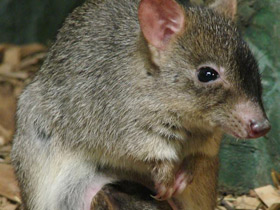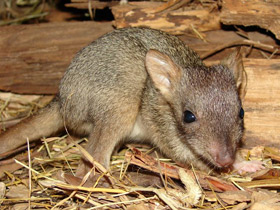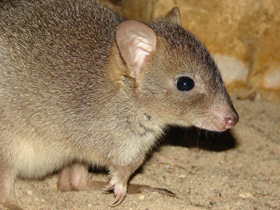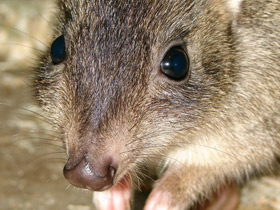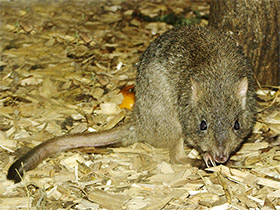The family Potoroidae
The woylie or brush-tailed bettong (Bettongia penicillata)
Potoroidae is a family of marsupials, small Australian animals known as bettongs, potoroos, and rat-kangaroos. All are rabbit-sized, brown, jumping marsupials and resemble a large rodent or a very small wallaby.
Taxonomy
The potoroids are smaller relatives of the kangaroos and wallabies, and may be ancestral to that group. In particular, the teeth show a simpler pattern than in the kangaroo family, with longer upper incisors, larger canines, and four cusps on the molars. However, both groups possess a wide diastema between the incisors and the cheek teeth, and the potoroids have a similar dental formula to their larger relatives:
Dentition
(3.0-1.2.4)/1.0.2.4
In most respects, however, the potoroids are similar to small wallabies. Their hind feet are elongated, and they move by hopping, although the adaptations are not as extreme as they are in true wallabies, and, like rabbits, they often use their fore limbs to move about at slower speeds.
The potoroids are, like nearly all diprotodonts, largely herbivorous. However, while they take a wide variety of plant foods, most have a particular taste for the fruiting bodies of fungi, and often depend on fungi to see them through periods when little else is available to eat in the dry Australian bush. One example of a potoroo that sustains itself on fungi is the long-footed potoroo. This animal's diet is almost entirely made up of fungal spores. This limits its habitat range as it needs to live in a moist environment, with dense cover to reduce predation from introduced species such as foxes and feral cats.
Ecology
The once populous species of this family played a role in the engineering of soil, dominating the sub-storey of vegetation, and regarded as crucial to the maintenance of the friable soils that they created by digging for fungi and other subsoil foods.
Status
Four modern species of bettongs are extant and two have become extinct. Bettongs were endangered because settlers took much of their habitat, and the red foxes they introduced to the continent also killed many of them. At one time, several species lived all over Australia. Today, the Tasmanian bettong lives only in the eastern half of Tasmania, and the northern bettong lives only in three isolated populations in northern Queensland.
The potoroines have exemplified the impact of ecological changes since colonisation of Australia. Most species have become extinct within their former distribution range, and are either totally extinct or conserved only by preservation in isolated habitat and re-population programs.
Classification
A basal branch of the macropods, the three extant genera of the Potoroidae contain eight species. The arrangements of the related taxa have seen an arrangement of the subfamilies within Potoroidae, although an earlier classification within the family Macropodidae has also been supported by genetic studies.
A conservative arrangement of modern and fossil taxa may be summarised as:
- family Potoroidae:
- subfamily †Palaeopotoroinae:
- genus Palaeopotorous;
- subfamily Potoroinae:
- genus Aepyprymnus;
- genus Bettongia;
- genus †Borungaboodie;
- genus †Milliyowi;
- genus †Caloprymnus;
- genus Potorous;
- genus †Purtia;
- genus †Wakiewakie;
- genus †Gumardee;
- subfamily †Bulungamayinae;
- genus Bulungamaya;
- genus Wabularoo;
- genus Wanburoo;
- genus Nowidgee;
- genus Ganguroo.
Description
Potoroids are small brown animals that look like large rodents or miniature wallabies. Their body length varies from 25 to 55 cm and their weight ranges from 1 to 3 kg. Their tail is fully pubescent and their legs resemble those of kangaroos, with large, elongated hind legs.
As in kangaroos, the IV toe of the hind legs is the most developed. The front legs are smaller than the hind legs. Potoroids move by hopping or on all four legs. Unlike kangaroos, kangaroos have well-developed canines; a total of 32-34 teeth.
The hatching pouch in females is well developed and opens forward; embryo development includes diapause. Potoroidae breed several times a year; there is one offspring per litter, which the female carries in the pouch for about 4 months.
Lifestyle and distribution
These swift animals inhabit dry scrub, thicket and woodland habitats. They live in burrows, crevices and build grass nests; they have a nocturnal lifestyle. Potoroids prefer plant food. Some species prefer to eat mushrooms and tubers, and occasionally eat insects.
In the late 18th century, Potoroidae were common throughout most of Australia, except in the far north and northeast. Today, their numbers have declined dramatically as they have been actively exterminated by introduced foxes and dogs.
The woylie or brush-tailed bettong (Bettongia penicillata)
The woylie or brush-tailed bettong (Bettongia penicillata) is a small, critically endangered, gerbil-like mammal native to forests and shrubland of Australia. A member of the rat-kangaroo family (Potoroidae), it moves by hopping and is active at night, digging for fungi to eat. It is also a marsupial and carries its young in a pouch. Once widespread, the woylie mostly died out from habitat loss and introduced predators such as foxes. It is currently restricted to two small areas in Western Australia. There are two subspecies: Bettongia penicillata ogilbyi in the west, and the now-extinct Bettongia penicillata penicillata in the southeast.
Taxonomy
A species was first described by J. E. Gray in 1837, based on the skin and skull of an adult male obtained by the Zoological Society of London, and placed with the British Museum of Natural History. The origin of the holotype has not been determined, but it is presumed to be New South Wales.
The two subspecies recognised are:
- Bettongia penicillata penicillata J.E. Gray, 1837. The nominate subspecies, classified as a modern extinction. This was the south-eastern subspecies.
- Bettongia penicillata ogilbyi (Waterhouse, 1841). This is the south-western subspecies. A description published as Hypsiprymnus ogilbyi, a species now recognised as the only extant subspecies of B. penicillata. The cited author is G. R. Waterhouse, who presented a manuscript prepared by John Gould. The type was collected at York, Western Australia.
The common name, "woylie", is derived from walyu in the Nyungar language. The regional variants amongst Nyungar peoples are noted as wol, woli and woylie. The spelling woylie, and its variants, were used for the species in reports and advertisements in Western Australian newspapers, and the spelling 'woylye' was added in the 1920s. The names boodie and boodie rat came to be applied by the rural inhabitants to several species in south-west Australia, including the woylie, and printed in references to them after 1897. However, the boodie (Bettongia lesueur) is now recognised as a separate species. The term "kangaroo rat" was also applied from the founding of the Swan River Colony, and was sometimes used to distinguish the species from the boodie. Another vernacular term applied to the woylie was "farting rat", inspired by the abrupt noise it emits when disturbed.
Description and habitat
Bettongia penicillata is a small, critically endangered, gerbil-like mammal native to the forests and bushlands of Australia. It belongs to the rat kangaroo family (Potoroidae).
Bettongia is a genus of diprotodontid marsupials in the family Potoroidae. It includes the bettongs, sometimes called kangaroo rats.
Bettongia penicillata is one of the rarest and smallest species of kangaroo rats. It is a small animal, weighing 1.1-1.6 kg and measuring 26-40 cm in length.
Bettongia penicillata inhabits the savannahs and tropical plains of Western Australia and feeds on insects, fungi, roots and bulbs, as well as the frozen sap of certain species of shrubs. During the summer and autumn, the kangaroo feeds exclusively on mushroom fruits, which it extracts from the ground.
They do not drink water and do not eat green plant parts. They feed in the evening and at night, and spend the day in a nest made of grass or bark.
The Bettongia penicillata uses its tail to transport plant material for its nest. In case of danger, this slow-moving animal jumps quickly, crouching low to the ground, arching its back and spreading its tail. These animals lead a solitary life.
Nutrition
Like the Potoroos and other Bettongia species, the woylie has a primarily fungivorous nutrition and will dig for a variety of its fruiting bodies. Although it can eat tubers, seeds, insects and the resin exuded by Hakea laurina, most of its nutrients come from underground fungi, which it extracts with its strong front claws. The fungi can only be digested indirectly. They are consumed by bacteria in part of its stomach. The bacteria produce the nutrients that are digested in the rest of the animal's stomach and small intestine. When widespread and abundant, the woylie probably played an important role in dispersing fungal spores in desert ecosystems.
The austral summer and autumn seasons provide woylies with the fruiting bodies of hypogeous fungi, and they are known to consume around 24 fungal taxa. During the summer months, truffle-like Mesophellia species constitute the bulk of their nutrition. The core of Mesophellia truffles is consumed by woylies, which avoid the hard outer shell, and has been analysed for its nutritional value. The nutrition is a rich source of lipids and trace elements accumulated by the fungus, and high levels of protein, which lack the necessary lycine and other amino acids, can be compensated for by fermentation processes on the available aminos cysteine and methionine within the digesta. In other seasons, woylies may adopt a more herbivorous range of nutrition, in addition to the hypogeous fungal bodies of that season.
Woylies have been observed eating the large seeds of the Australian sandalwood, Santalum spicatum, a nutrition that the animal places in a shallow cache for later consumption. It is likely that the habit of storing the seeds played an important role in the dispersal of the tree. However, Australian sandalwood was a commercially valuable tree and was felled during colonisation. Introduced populations of woylies on an island off the coast of South Australia consume mainly plant material, tubers and roots, seeds and leaves, and beetles, a nutrition considered unusual for the species. Analysis of the nutrition of this colony showed that it included fungal spores, as detected in its droppings, although it is likely to have been an occupant of the beetles' guts.
Reproduction and conservation status
Pregnancy in Bettongia penicillata lasts 21 days, the female gives birth to a brood, which spends 98 days in the pouch and thereafter does not leave the maternal nest. Females reach sexual maturity at 170-180 days and give birth to young every 100 days for 4-6 years.
The species is on the verge of extinction and is on the IUCN Red List. It has been virtually wiped out by cats and foxes introduced to Australia by European settlers. The kangaroo is being bred in captivity for reintroduction into the wild.

















